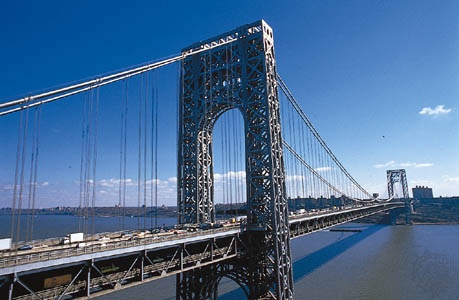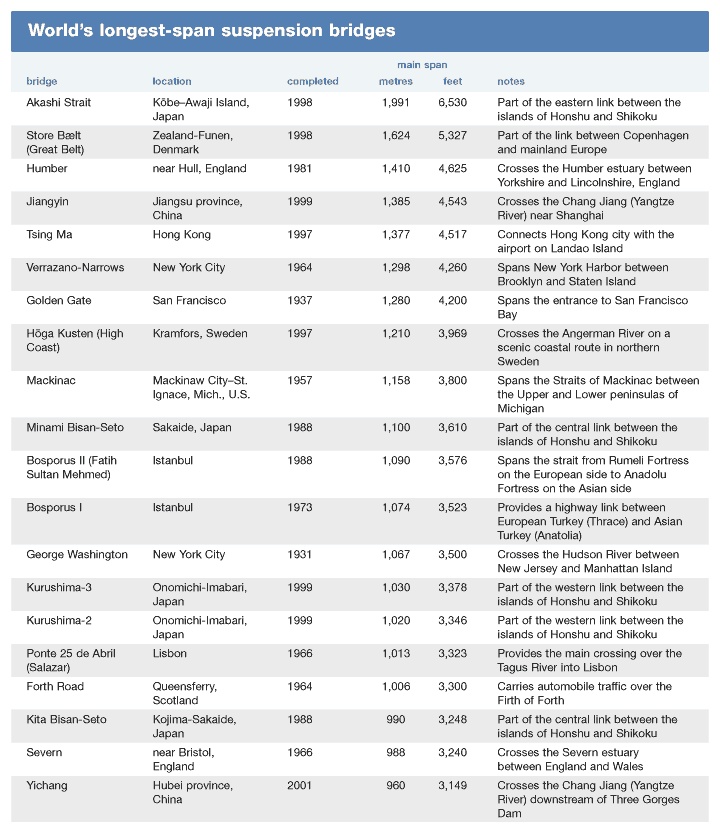suspension bridge
engineering
 bridge with overhead cables supporting its roadway. One of the oldest of engineering forms, suspension bridges were constructed by primitive peoples using vines for cables and mounting the roadway directly on the cables. A much stronger type was introduced in India about the 4th century AD that used cables of plaited bamboo and later of iron chain, with the roadway suspended.
bridge with overhead cables supporting its roadway. One of the oldest of engineering forms, suspension bridges were constructed by primitive peoples using vines for cables and mounting the roadway directly on the cables. A much stronger type was introduced in India about the 4th century AD that used cables of plaited bamboo and later of iron chain, with the roadway suspended. In modern times, the suspension bridge provided an economical solution to the problem of long spans over navigable streams or at other sites where it is difficult to found piers in the stream. British, French, American, and other engineers of the late 18th and early 19th centuries encountered serious problems of stability and strength against wind forces and heavy loads; failures resulted from storms, heavy snows, and droves of cattle. Credit for solving the problem belongs principally to John Augustus Roebling (Roebling, John Augustus), a German-born American engineer who added a web truss to either side of his roadways and produced a structure so rigid that he successfully bridged the Niagara Gorge at Niagara Falls, New York, the Ohio River at Cincinnati, and, finally, in his masterpiece, the East River between Brooklyn and Manhattan at New York City.
In modern times, the suspension bridge provided an economical solution to the problem of long spans over navigable streams or at other sites where it is difficult to found piers in the stream. British, French, American, and other engineers of the late 18th and early 19th centuries encountered serious problems of stability and strength against wind forces and heavy loads; failures resulted from storms, heavy snows, and droves of cattle. Credit for solving the problem belongs principally to John Augustus Roebling (Roebling, John Augustus), a German-born American engineer who added a web truss to either side of his roadways and produced a structure so rigid that he successfully bridged the Niagara Gorge at Niagara Falls, New York, the Ohio River at Cincinnati, and, finally, in his masterpiece, the East River between Brooklyn and Manhattan at New York City.The technique of cable spinning for suspension bridges was invented by the French engineer Louis Vicat, a contemporary of Roebling. Vicat's method employed a traveling wheel to carry the continuous cable strand from the anchorage on one side up over the tower, down on a predetermined sag (catenary) to the midpoint of the bridge, up and over the tower on the farther side to the farther anchorage, where a crew received the wheel, anchored the strand, and returned the wheel, laying a fresh strand. From these successive parallel strands a cable was built up.
Another major development in the modern suspension bridge was the pneumatic caisson, which permitted pier foundation at great depths. It was used initially by French, British, and American engineers, including Washington Roebling, who completed his father's Brooklyn Bridge.
For a time in the 1930s, American engineers experimented with a narrow solid girder in place of the web truss to stiffen the roadway, but the failure of the Tacoma Narrows Bridge in 1940 under aerodynamic forces instigated a return to the web truss. Later, aerodynamically stable box girders replaced the web truss.
By the late 1980s, three suspension bridges (the Golden Gate (Golden Gate Bridge), in San Francisco, the Verrazano-Narrows (Verrazano-Narrows Bridge), in New York City, and the Humber Bridge, near Hull, England) had main-span lengths of more than 4,000 feet (1,200 metres). Modern steel alloys are considered capable of much greater spans. Though suspension bridges can be made strong enough to support freight trains, they have nearly all been designed for automobile traffic.
A cable-braced bridge was developed by German engineers at Cologne, Düsseldorf, and elsewhere in the 1950s and '60s; in this form a single tower at the midpoint supports the roadway by means of a number of cables. Another development of the 1960s, aimed at reducing time of construction, was cable fabricated in the shop.
- trumpet creeper
- trumpeter
- trumpet fish
- trumpet marine
- Trumpler, Robert Julius
- trundle bed
- Trungpa, Chögyam Rinpoche
- Trung Sisters
- Truong Chinh
- Truro
- truss
- trust
- trust company
- trusteeism
- Trusteeship Council
- Trust Territory of the Pacific Islands
- truth commission
- Truth or Consequences
- Truth, Sojourner
- truth-value
- TRW Inc.
- Tryggve Andersen
- Trygve Bratteli
- Trygve Haavelmo
- Trygve (Halvdan) Lie